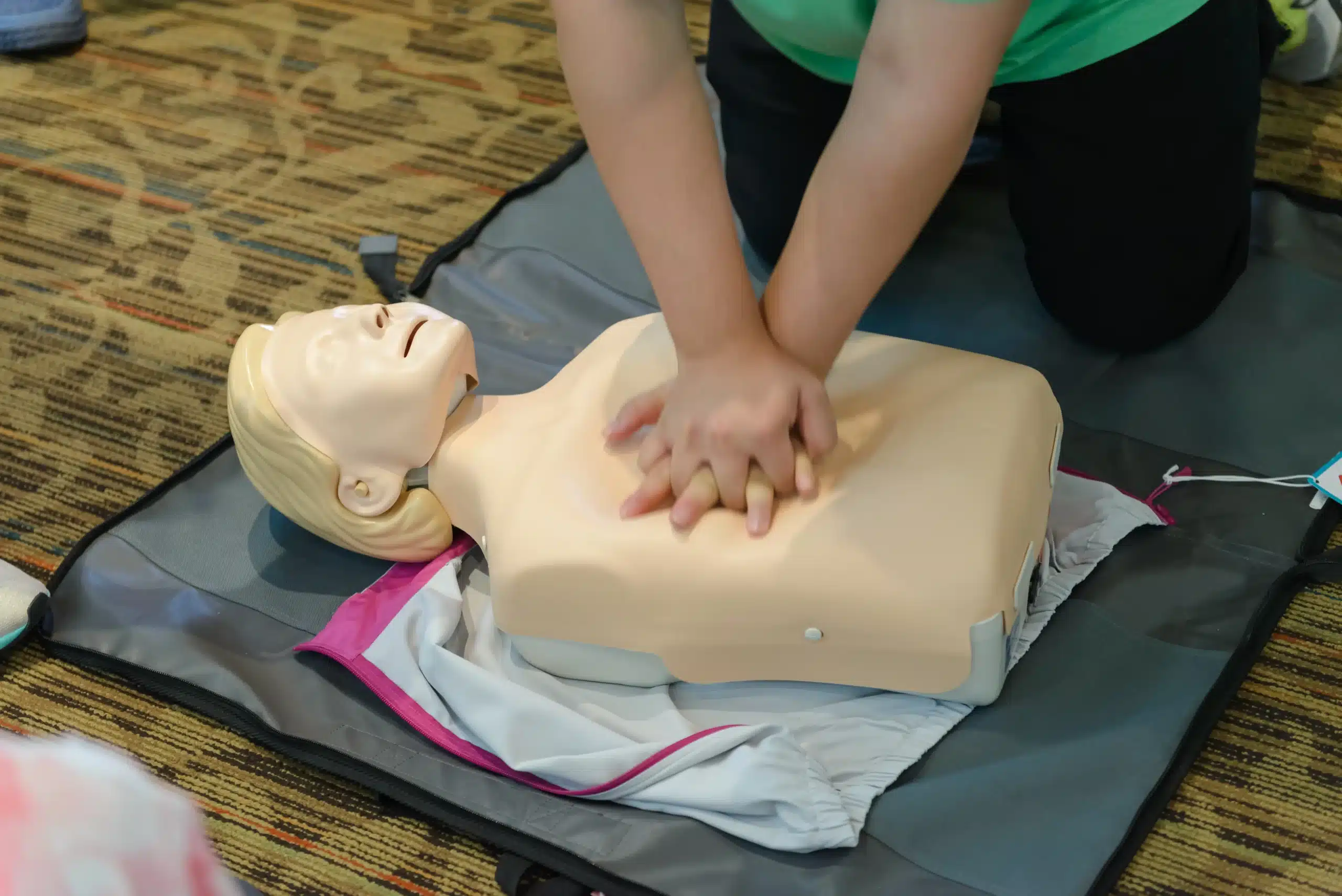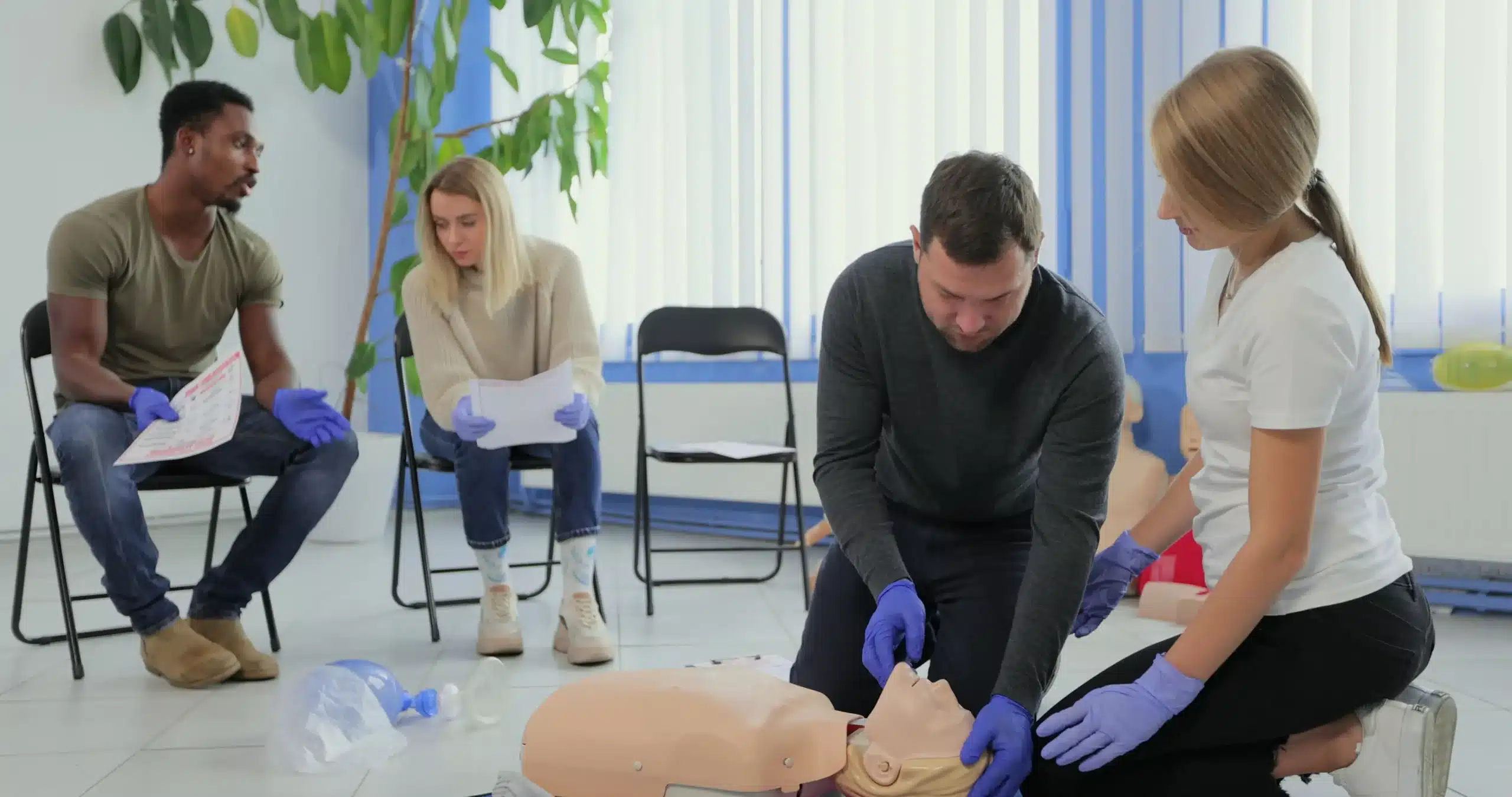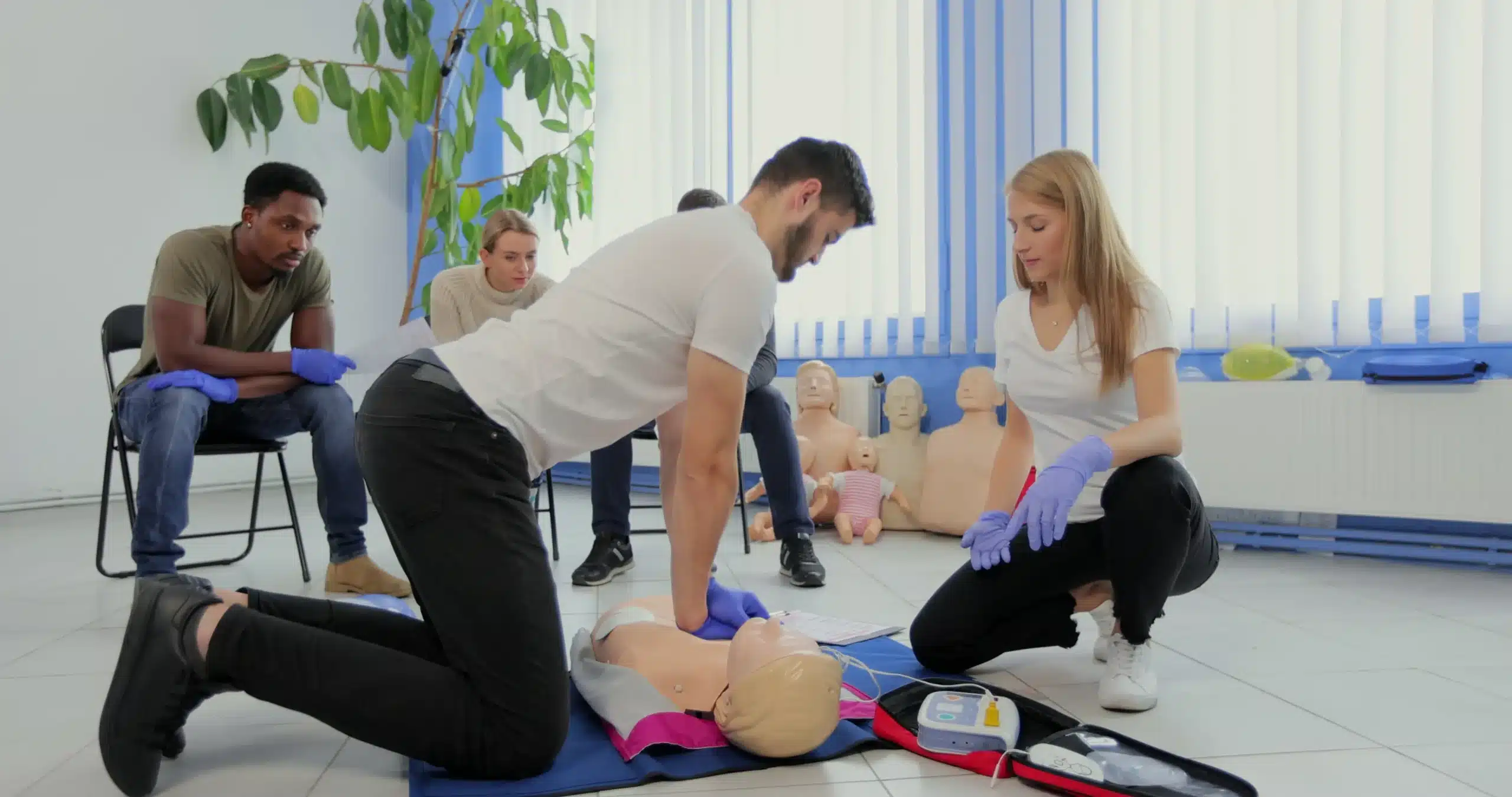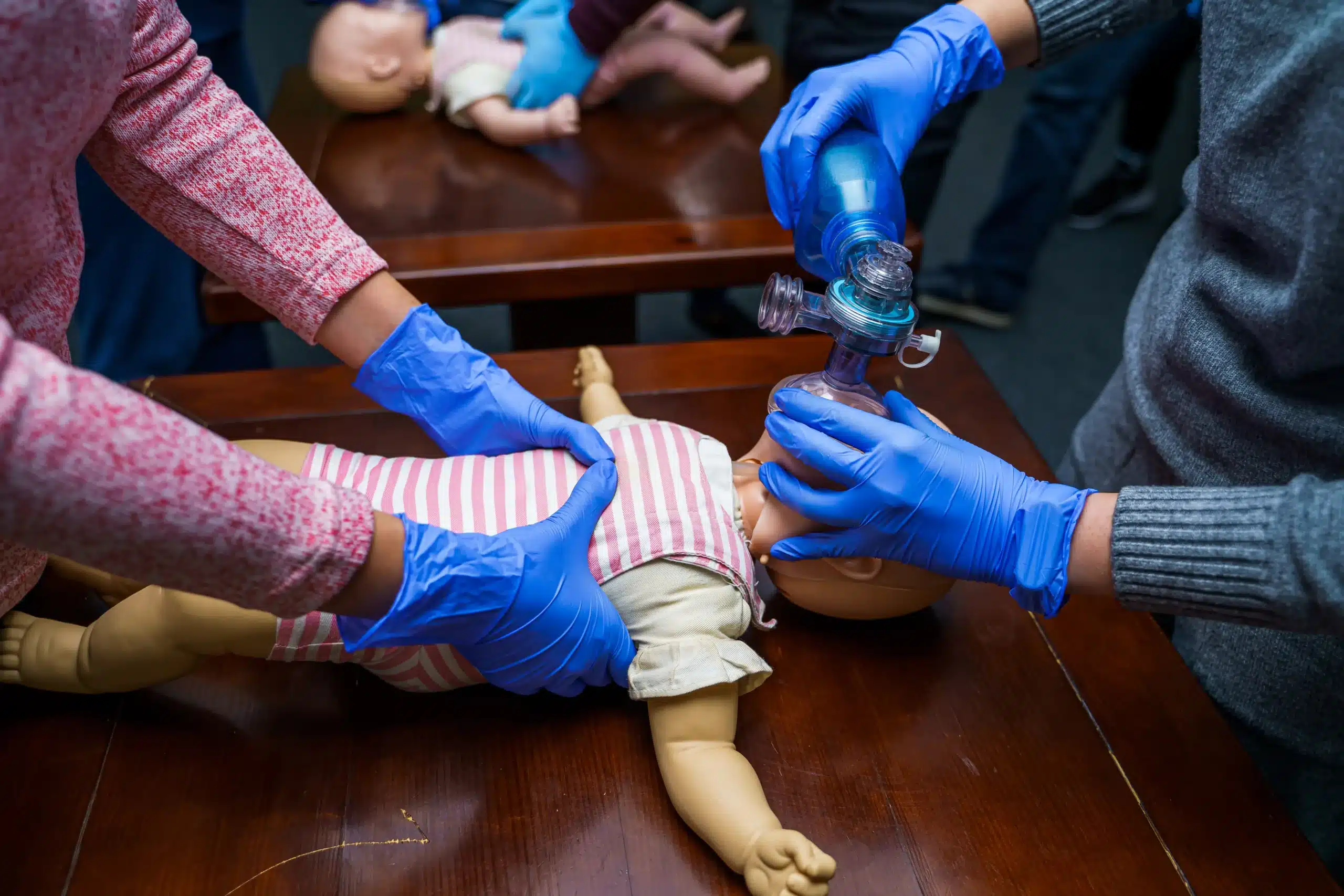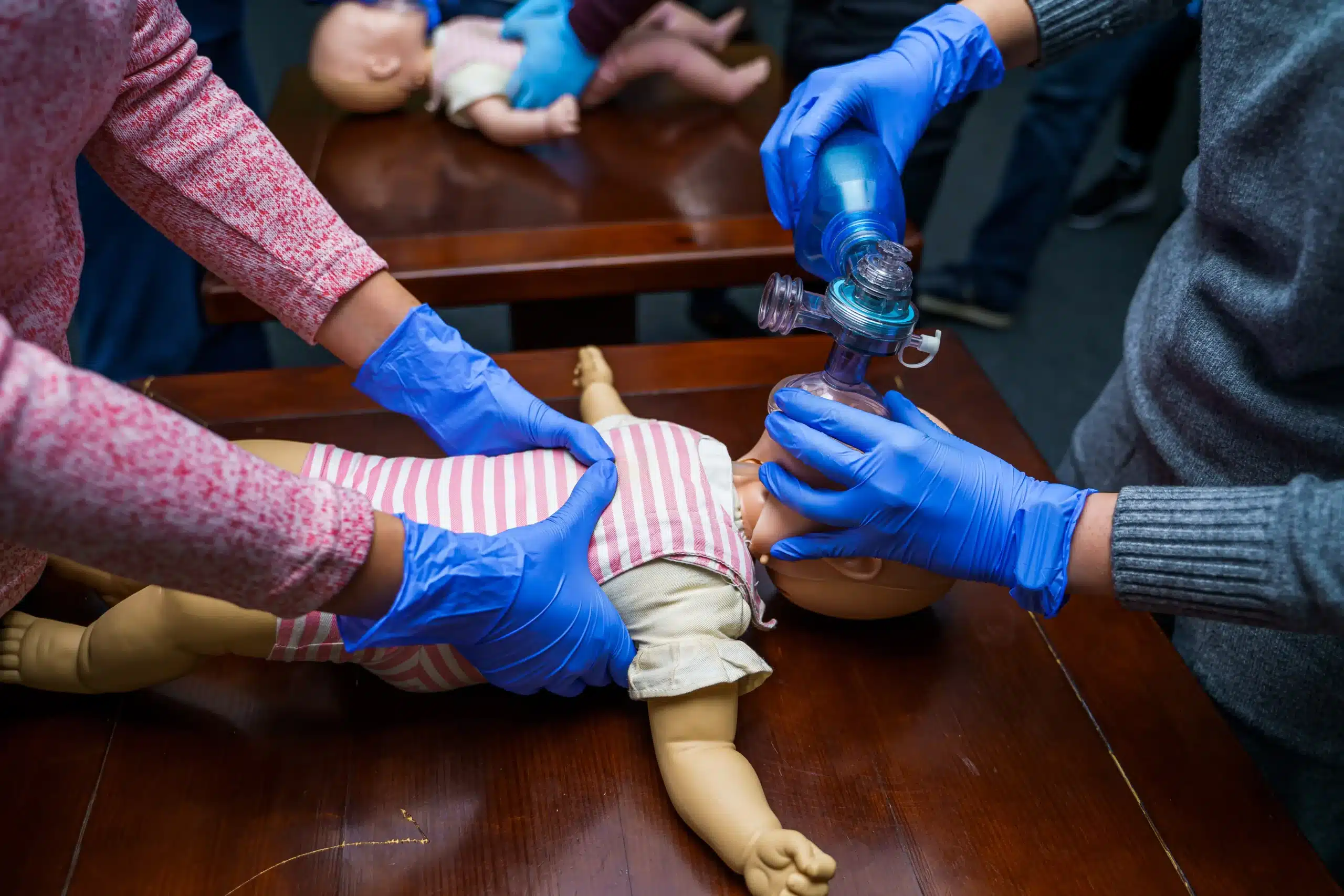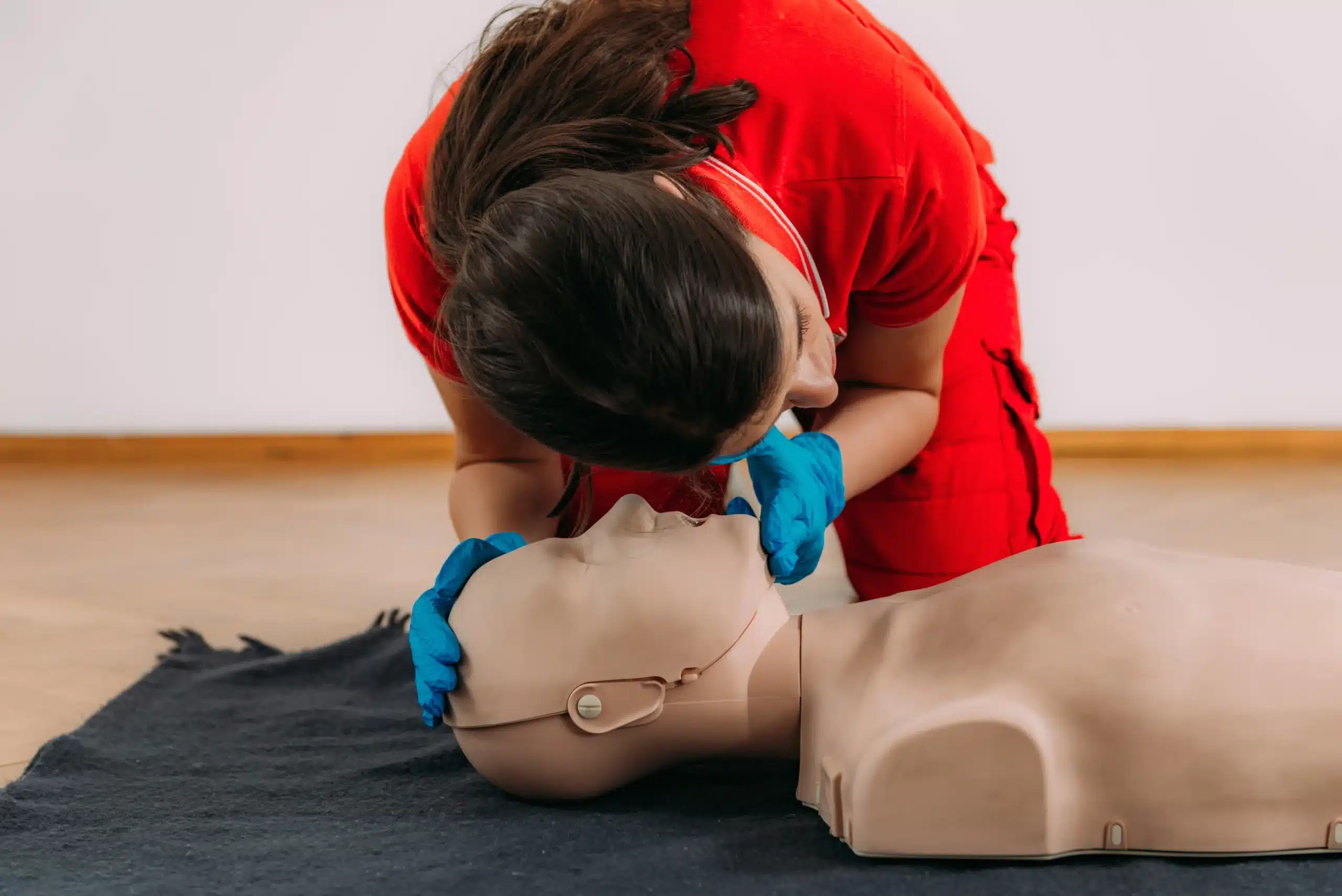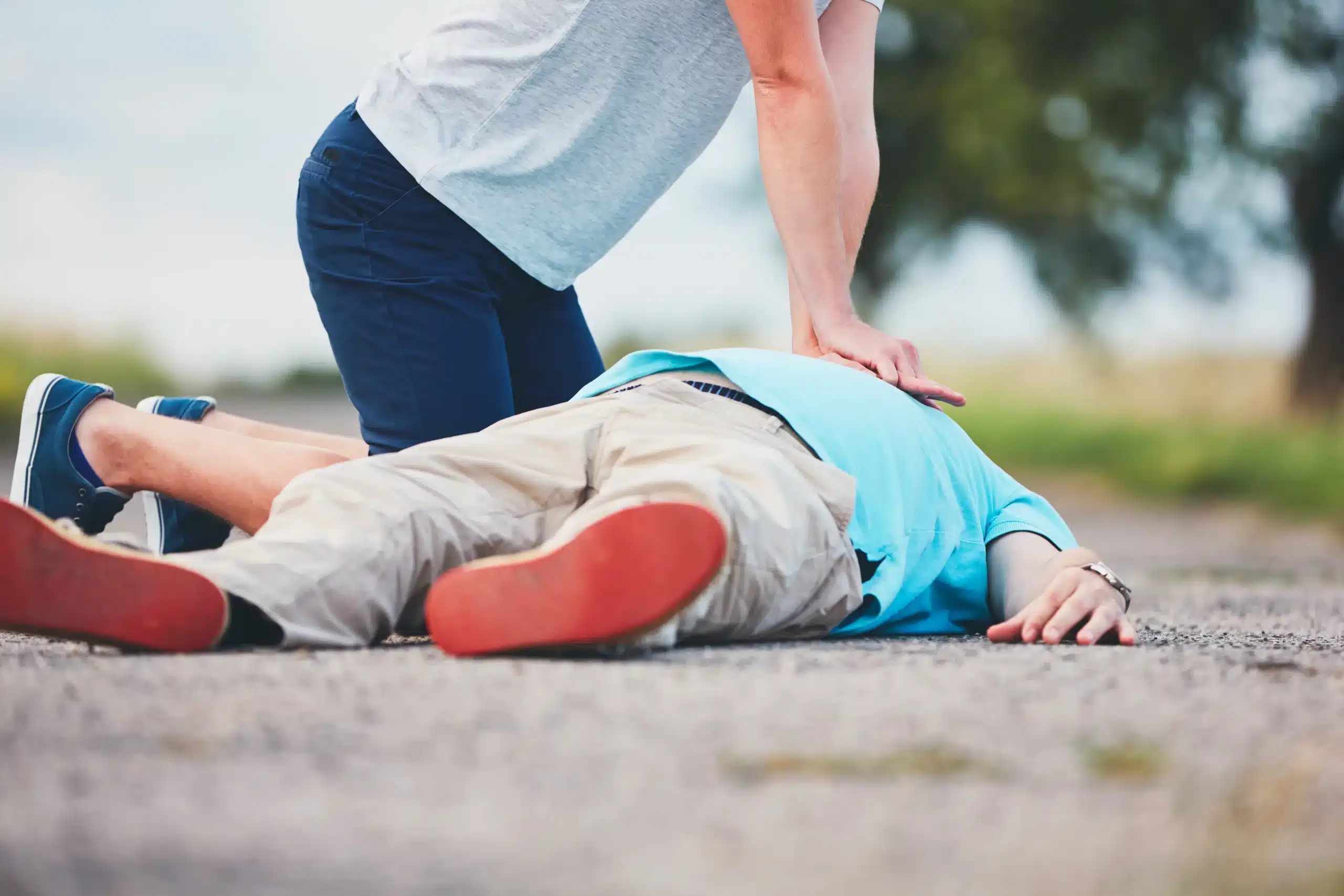Empowering yourself with life-saving skills is one of the most valuable things you can do. Basic Life Support (BLS) training equips you to respond confidently in medical emergencies, providing essential care until professional help arrives. This guide is your go-to resource for understanding BLS, from the core skills covered to finding BLS classes near me. We’ll explore the differences between BLS and CPR, the various class formats available (in-person, online, and blended learning), and how to choose a reputable training provider. Whether you’re a healthcare professional seeking certification or an individual wanting to learn essential life-saving techniques, this guide will help you on your BLS journey.
Key Takeaways
- BLS certification equips you to handle medical emergencies: Whether you’re a healthcare professional or simply want to learn life-saving skills, BLS training provides the knowledge and skills to respond to cardiac arrest, respiratory distress, and choking. Look for AHA-certified courses for comprehensive training.
- Different BLS class formats cater to various learning styles: In-person classes offer hands-on learning, while blended learning combines online coursework with in-person skills practice. Online-only options cover the cognitive part of AHA courses, but an in-person skills check is always required for certification.
- Preparation is key to a successful BLS learning experience: Check for required materials and pre-course study recommendations. Dress comfortably for hands-on practice and be prepared for an active learning environment. Remember to recertify every two years to maintain your BLS skills.
What are BLS Classes & Why are They Important?
Basic Life Support (BLS) classes teach essential skills for responding to medical emergencies like cardiac arrest, respiratory distress, and choking. These courses empower healthcare providers, first responders, and other professionals to confidently administer life-saving care. BLS certification is often a job requirement for many healthcare roles and demonstrates a commitment to patient safety. It’s crucial for improving patient outcomes during these critical incidents, giving participants the knowledge and techniques to make a real difference. The American Health Training website emphasizes how important BLS certification is for healthcare professionals. At Merced CPR Classes, we offer comprehensive BLS training to prepare you for these critical situations.
BLS Skills
BLS training covers a range of vital skills, including how to use an automated external defibrillator (AED), a portable device that can analyze heart rhythms and deliver an electric shock to restore a normal heartbeat. You’ll also learn airway management techniques, ensuring you can help someone breathe effectively during an emergency. Additionally, BLS classes teach you how to assist someone who is choking, a skill that can prevent serious complications. Medtigo highlights these core skills as central to BLS training. Our courses at Merced CPR Classes cover all these skills and more, preparing you to handle various emergency situations. We offer group discounts to make training more accessible for teams and organizations.
BLS vs. CPR
While both aim to save lives, BLS and CPR have distinct differences. BLS (Basic Life Support) certification is geared towards healthcare professionals and first responders, providing a comprehensive approach to managing medical emergencies. It builds upon the foundation of CPR and adds advanced techniques for handling cardiac arrest, respiratory issues, and airway obstructions. The Red Cross explains this distinction clearly. CPR (Cardiopulmonary Resuscitation), focuses on the immediate life-saving steps anyone can take during cardiac arrest. It emphasizes chest compressions and rescue breaths—essential techniques for maintaining blood circulation and oxygenation until professional help arrives. The Red Cross website also clarifies the core components of CPR training. Think of CPR as the foundation, while BLS builds upon it with more advanced skills and knowledge for healthcare providers. If you’re pursuing a career in healthcare, BLS certification is likely a necessity. Review our low price guarantee and find a class that fits your budget.
BLS Class Types Near You
Choosing the right BLS class format depends on your learning style, schedule, and preferences. Let’s explore the most common types available.
In-Person Classes
In-person BLS classes offer a traditional learning environment with face-to-face instruction. These courses combine classroom learning with hands-on practice, allowing you to engage directly with instructors and fellow students. This format is ideal for those who thrive in interactive settings and benefit from real-time feedback. You’ll have the opportunity to ask questions, clarify doubts, and practice skills under the watchful eye of a certified instructor. This direct interaction can be especially helpful for mastering essential techniques like CPR and using an AED.
Online BLS Certification
While the American Heart Association (AHA) requires an in-person skills assessment for BLS certification, the online portion offers flexibility in completing the cognitive coursework. As pointed out on AllNurses.com, there’s no fully online, AHA-certified BLS course. This blended approach allows you to learn the theoretical aspects of BLS at your own pace, then demonstrate your skills in a practical setting. However, be aware that online-only options might not meet all workplace requirements. The Red Cross clarifies that these courses may not satisfy OSHA standards or professional licensing requirements. So, if you’re pursuing BLS certification for your job, double-check what’s required.
Blended Learning
Blended learning offers a convenient middle ground between fully in-person and online-only courses. This format combines online coursework with in-person skills practice. This approach provides flexibility for busy schedules while still ensuring you receive the hands-on training necessary for effective BLS. You can work through the online modules at your convenience, then attend an in-person session to practice and refine your skills. The Red Cross highlights the benefits of this combined approach, emphasizing the convenience it offers learners. Blended learning is a great option if you need to balance work, family, or other commitments while pursuing BLS certification.
Find Reputable BLS Classes
Finding the right BLS certification class is crucial, especially for healthcare providers and other professionals who need this life-saving skill. A certification approved by a reputable organization like the American Heart Association (AHA) is often a requirement for many employers. So, how do you find a class that fits your needs and provides high-quality training? Here’s how to find reputable BLS classes:
Use Online Search Tools
Start your search online. A simple search for “BLS classes near me” will generate a list of potential training providers in your area. You can also use more specific search terms, like “American Heart Association BLS classes” if you’re looking for AHA-certified courses. Websites like the American Heart Association and the American Red Cross often have search tools to help you locate certified instructors and training centers. Don’t forget to check reviews and ratings of different providers to get a sense of their reputation and the quality of instruction.
Check Local Healthcare Facilities
Hospitals, clinics, and other healthcare facilities frequently offer BLS classes for their staff and the community. Contacting your local hospitals or checking their websites is a great way to find reputable BLS classes. These courses are often taught by experienced healthcare professionals and provide hands-on training with the latest equipment. Knowing BLS principles is important for healthcare workers and patient safety. Many healthcare professionals misunderstand BLS protocol, which can negatively impact patient care.
Evaluate Providers
Once you’ve identified a few potential providers, take the time to evaluate them thoroughly. Look for providers who offer AHA-approved certification, as this is widely considered the gold standard for BLS training. Check if the instructors are experienced and certified. A good provider will also offer convenient class schedules, reasonable pricing, and a comfortable learning environment. Consider factors like class size; smaller classes often allow for more personalized instruction and feedback. Don’t hesitate to contact the provider directly to ask questions about their courses, instructors, and certification process. BLS training is important in many emergencies. Some people mistakenly believe BLS training is only for healthcare professionals. It’s important to understand that BLS certification training includes the use of automated external defibrillators (AEDs), basic airway management, and techniques for assisting someone who is choking. Remember, choosing a reputable provider ensures you receive high-quality training that meets industry standards and prepares you to respond confidently in emergencies. Merced CPR Classes offers a low price guarantee and group discounts. Check out our course preparation page to learn more.
What Happens During BLS Training?
So, you’ve signed up for a BLS course—congratulations! Now, you’re probably wondering what to expect. A typical BLS class blends theory and practical exercises to give you a well-rounded understanding of life-saving techniques. Let’s break down the key components:
Class Structure & Duration
BLS certification courses typically run for about three hours, whether you choose an in-person or blended learning format. Blended learning usually involves completing an online portion before attending an in-person skills session. This approach offers flexibility for those with busy schedules. Regardless of the format, expect a structured learning experience covering essential BLS concepts and skills. Your BLS certification will remain valid for two years.
Hands-on Practice
BLS classes aren’t just about lectures and textbooks. Hands-on practice is a core element of the training. You’ll work with realistic training equipment, including mannequins, to simulate real-life emergency scenarios. This practical training helps build muscle memory and confidence, allowing you to react effectively in stressful situations. Expert instructors will guide you through each step, providing feedback and ensuring you master the necessary techniques.
Certification Exam
To earn your BLS certification, you’ll complete a skills check-off at the end of the course. This in-person evaluation assesses your ability to perform the techniques learned during class. Your instructor will prepare you thoroughly, so there’s no need to feel intimidated. Once you successfully complete the exam, you’ll receive your BLS certification, valid for two years. As your certification nears its expiration, remember to sign up for a recertification course to maintain your skills.
BLS Class Costs & Value
Understanding the cost of BLS classes and what you get for your money is an important part of choosing the right course. Let’s break down average pricing, potential discounts, and the long-term value of your certification, especially here at Merced CPR Classes, serving Merced, Turlock, and Atwater, CA.
Average Pricing
BLS class costs vary based on location, the training provider, and the type of course you choose (in-person, blended learning, or online). You can expect to find BLS certification courses between $70 and $90. For example, CPR Certification Brooklyn offers AHA-certified BLS training for $74.95. This price range generally covers comprehensive training that meets industry standards and includes your certification card. Always confirm exactly what’s included in the course fee to avoid surprises. At Merced CPR Classes, we maintain competitive pricing and offer a low price guarantee to ensure you’re getting the best possible value.
Group Discounts
If you’re training a team or group of people, look for group discounts. Many providers, including Merced CPR Classes, offer reduced rates for group classes. This can be a smart way to save money while ensuring everyone receives consistent, high-quality training. Contact providers directly to discuss your specific needs and negotiate the best group rate. This is particularly helpful for businesses, healthcare facilities, or community organizations.
Recertification
Your BLS certification isn’t forever. Most certifications are valid for two years. Factor in recertification costs when planning your training budget. Many organizations, like the American Red Cross, offer recertification courses, often at a lower cost than initial certification. Plan to recertify within 30 days of your certification expiring to maintain your credentials and avoid any lapse in your qualification. Staying current with your BLS skills is essential for providing effective care and maintaining professional standards. Check with your employer or licensing board for specific recertification requirements in your field.
Choose the Right BLS Class
Choosing the right BLS class depends on your specific needs and career goals. Whether you’re a healthcare professional or just want to learn life-saving skills, understanding the different BLS class options will help you make an informed decision. Let’s explore some key considerations:
Healthcare Professional Requirements
BLS certification is essential for healthcare providers. It plays a crucial role in improving patient outcomes during emergencies, equipping professionals with the skills to respond effectively to cardiac arrest, respiratory distress, and other life-threatening situations. Many healthcare providers mistakenly believe that BLS certification is a one-time requirement. However, maintaining up-to-date skills through regular recertification is vital for ensuring competency and staying current with the latest guidelines. This is crucial for healthcare professionals committed to providing optimal patient care. For those seeking American Heart Association-aligned training, resources like the AHA’s BLS course information can be invaluable.
Options for Non-Healthcare Workers
While often associated with healthcare professionals, BLS training is valuable for anyone who wants to learn life-saving skills. It empowers individuals to respond confidently to emergencies in various environments, from homes and workplaces to public spaces. BLS training encompasses essential skills such as using an automated external defibrillator (AED), performing basic airway management, and assisting someone who is choking. These skills can make a profound difference in a critical situation, even outside of a hospital setting. If you’re interested in learning more about group discounts for BLS training, explore options for group CPR discounts.
Specialized BLS Training
Beyond the core BLS curriculum, specialized training caters to specific professional needs. For instance, healthcare practices can enhance their life-saving capabilities by implementing comprehensive BLS training programs. This specialized training ensures that all team members are well-prepared to respond effectively to medical emergencies within their specific practice setting. To prepare for your upcoming BLS class, review the course preparation guidelines to ensure you have the necessary materials and information. Additionally, if cost is a concern, explore our low price guarantee to find affordable training options.
Prepare for Your BLS Class
Getting ready for your BLS class involves a bit of prep work—both mental and physical. Knowing what to expect and how to prepare can make your learning experience smoother and more effective.
Required Materials & Pre-Course Study
Some BLS courses may require you to purchase a student handbook beforehand. Check with your chosen provider, like Merced CPR Classes, to see if this applies to you and if any pre-course study is recommended. Providers often list required materials on their websites. Reviewing any provided pre-course materials can give you a head start. Understanding key BLS principles ahead of time, including basic airway management, AED use, and choking techniques, will help you get the most out of your in-class time.
Physical Considerations
BLS certification involves hands-on practice and physical activity. Wear comfortable clothing that allows for a full range of motion. You’ll be practicing skills like chest compressions and rescue breaths, so comfortable athletic wear is usually a good choice. Be prepared to be on your feet for a good portion of the class. BLS skills are applicable in diverse settings, so the training often involves moving around and simulating real-world scenarios. Staying current with your training ensures you’re ready for anything, and being physically prepared for the class itself is a great first step.
Top BLS Training Providers
Finding the right BLS training provider is crucial for receiving high-quality instruction and a recognized certification. Here are some of the leading organizations offering BLS classes:
American Heart Association
The American Heart Association (AHA) sets the standard for BLS training and certification. Many healthcare employers require AHA-certified BLS providers, making it a preferred choice for medical professionals. The AHA provides comprehensive training materials and emphasizes high-quality CPR and emergency cardiovascular care. Explore their BLS course options to find one that fits your needs.
American Red Cross
The American Red Cross is another well-respected provider of BLS training. They offer various course formats, including in-person, online, and blended learning, making it easy to find a class that works with your schedule. The Red Cross focuses on giving individuals the knowledge and skills to respond confidently in emergencies. Learn more about their BLS certification.
National Safety Council
The National Safety Council (NSC) offers BLS training as part of their broader focus on safety and injury prevention. NSC-certified instructors deliver training that meets national standards, equipping participants with the skills to handle various emergency situations. Visit the National Safety Council website for more information on their training programs.
American Safety & Health Institute
The American Safety & Health Institute (ASHI) provides BLS training with a focus on practical application and hands-on skills. Their courses prepare individuals for real-world emergencies, emphasizing the importance of effective response. Find details about their BLS training programs.
Merced CPR Classes
For those in the Merced, Turlock, and Atwater areas, Merced CPR Classes offers convenient and affordable BLS training. They provide group discounts and a low-price guarantee, making high-quality training accessible. Review their course preparation information and register for a class on their website.
Common BLS Class Misconceptions
It’s easy to get confused about BLS certification, especially with so much information online. Let’s clear up some common misunderstandings.
Online-Only Certification Myths
One of the biggest misunderstandings about BLS certification is that you can get it 100% online. The American Heart Association (AHA) requires an in-person skills assessment, no matter what. While the course content may be delivered online, you’ll still need to demonstrate your skills to a certified instructor. Some students find online learning challenging, citing issues with the technology or interactive elements. If you prefer hands-on learning from the start, a traditional in-person class might be a better fit.
Who Needs BLS Training?
Another misconception is that only doctors and nurses need BLS training. The truth is, anyone can benefit from these lifesaving skills. BLS certification covers essential techniques like using an AED, basic airway management, and helping someone who is choking. These skills are valuable in various settings, from healthcare facilities and schools to workplaces and even at home. Consider BLS training to prepare yourself for emergencies.
Maintain Your BLS Skills
Finally, some people believe BLS certification is a one-time thing. In reality, your certification expires, and it’s crucial to stay up-to-date with the latest guidelines and techniques. Regularly refreshing your skills ensures you can provide effective assistance in an emergency. Ongoing education is key to maintaining your life-saving capabilities. Check with your certifying organization, such as the AHA, for recertification requirements and options.
Related Articles
- BLS Courses in Atwater: Your Guide – Merced CPR Classes
- Basic Life Support in Atwater: A Practical Guide – Merced CPR Classes
- BLS Recertification Near Me: Your Complete Guide – Merced CPR Classes
- BLS Training in Turlock: Your Complete Guide – Merced CPR Classes
- BLS ACLS Classes in Merced CA: Your Guide – Merced CPR Classes
Frequently Asked Questions
What’s the main difference between BLS and CPR? CPR focuses on immediate life-saving actions like chest compressions and rescue breaths, while BLS builds upon those basics with more advanced techniques for healthcare providers and first responders. Think of CPR as the foundation and BLS as the next level up.
How long does a BLS certification last, and how do I renew it? BLS certification is typically valid for two years. To renew, you’ll need to take a recertification course before your current certification expires. Check with your certifying organization or training provider for specific requirements and available courses.
Are there fully online BLS certification courses available? While some coursework may be online, the American Heart Association (AHA) requires an in-person skills assessment for BLS certification. So, there’s no entirely online option if you need AHA certification. Check with your employer or licensing board to ensure any online components meet their requirements.
What should I expect during a BLS class? Expect a mix of classroom learning and hands-on practice. You’ll learn essential techniques like CPR, AED use, and airway management. Be prepared for interactive sessions, working with training equipment, and a final skills evaluation to earn your certification.
How much do BLS classes typically cost, and are there ways to save money? BLS class costs vary but generally fall between $70 and $90. Look for group discounts if you’re training with others. Some providers also offer discounts for students, military personnel, or other groups. Always compare prices and check what’s included in the course fee before registering.
